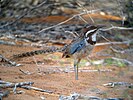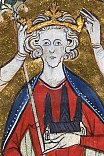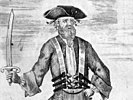Wikipedia:Today's featured article/October 2017
| << | Today's featured articles for October 2017 | >> | ||||
|---|---|---|---|---|---|---|
| Su | Mo | Tu | We | Th | Fr | Sa |
| 1 | 2 | 3 | 4 | 5 | 6 | 7 |
| 8 | 9 | 10 | 11 | 12 | 13 | 14 |
| 15 | 16 | 17 | 18 | 19 | 20 | 21 |
| 22 | 23 | 24 | 25 | 26 | 27 | 28 |
| 29 | 30 | 31 | ||||
October 1
The Founding Ceremony of the Nation is a 1953 oil painting by Chinese artist Dong Xiwen. It depicts Mao Zedong and other Communist officials inaugurating the People's Republic of China at Tiananmen Square on October 1, 1949. A prominent example of socialist realism, it is one of the most celebrated works of official Chinese art. After the Communists took control of China, they sought to memorialize their achievements through artworks. Dong was commissioned, and completed the oil painting in three months in a folk art style, drawing on historical Chinese art. The success of the painting was assured when Mao viewed it and liked it, and it was reproduced in large numbers for display in homes. Dong was ordered to remove Gao Gang from the painting in 1954 and Liu Shaoqi in 1967, after government purges. In 1972 a reproduction was painted by other artists to accommodate another deletion. After the purged officials were rehabilitated, the replica was modified in 1979 to include them. Both canvases are in the National Museum of China in Beijing. (Full article...)
October 2

The 1926 World Series of Major League Baseball began on October 2 at Yankee Stadium, pitting the St. Louis Cardinals against the New York Yankees. The National League champion Cardinals defeated the American League champion Yankees four games to three. This was the first World Series appearance for the Cardinals, and the first of eleven World Series championships in Cardinals history, while the Yankees were in their fourth World Series in six years. In the Yankees' 10–5 Game 4 win, Babe Ruth hit three home runs, a World Series record that has been equaled only four times since. According to newspaper reports, Ruth had promised before the game that he would hit a home run and dedicate it to a sickly boy named Johnny Sylvester. An alternative version of this story, later portrayed in The Babe Ruth Story, claims that Ruth went to Sylvester's hospital bed and made the promise in person. This story is disputed by contemporary baseball historians, but it remains one of the most famous anecdotes in baseball history. (Full article...)
October 3
Confusion is a 1975 studio album by Nigerian Afrobeat musician Fela Kuti (pictured) and his band. It was arranged, composed, and produced by Kuti, who emphasized his African heritage and nationalism on the album. Confusion is a commentary on post-colonial Lagos and its lack of infrastructure and proper leadership. Kuti's pidgin English lyrics depict difficult conditions in the city, including frenetic, multilingual street markets and inextricable traffic jams at Lagos' major intersections. Confusion is a one-song Afrobeat album with an entirely instrumental first half featuring free form interplay between Kuti's electric piano and Tony Allen's percussion. It leads to an extended mid-tempo section with polyrhythms by Allen and tenor saxophone by Kuti, who follows with call-and-response vocal passages. Since the record's release by EMI, it has been praised by music critics, who found it exemplary of Kuti's Afrobeat style and recommended it as a highlight from his extensive catalog. In both 2000 and 2010, Confusion was reissued and bundled with Kuti's 1973 Gentleman album. (Full article...)
October 4
The 2005 Azores subtropical storm was the nineteenth nameable storm of that year's record-breaking Atlantic hurricane season. It developed on October 4 in the eastern Atlantic Ocean out of a low-pressure area that gained subtropical characteristics. Crossing over the Azores later that day, it became extratropical again the following day. No damage or fatalities were reported. The storm was not officially named by the US National Hurricane Center as it was classified at the time as a non-tropical low, partly due to its unusual location and wide wind field. Months after the hurricane season, when the Center was performing its annual review of the season and its named storms, forecasters Jack Beven and Eric Blake identified a well-defined center convecting around a warm core—the hallmark of a subtropical storm. After being absorbed into a cold front, the system went on to become Hurricane Vince. Weakening to a tropical depression, this storm became the first tropical system to make landfall on the Iberian Peninsula since the 1842 Spain hurricane. (Full article...)
October 5
Cosmo Gordon Lang (1864–1945) was a prelate of the Church of England who served as Archbishop of York (1908–1928) and Archbishop of Canterbury (1928–1942). He was a parish priest in Leeds and Portsmouth, and a suffragan Bishop of Stepney, before his surprise appointment as Archbishop of York. A controversial speech in the House of Lords in 1908, against the Lords' proposal to reject David Lloyd George's 1909 "People's Budget", marked him as a radical, although he soon discarded this reputation. After the First World War he promoted church unity, and supported the failed attempt to revise the Book of Common Prayer. As Archbishop of Canterbury during the 1930s Lang condemned European fascism and anti-semitism. However, he later supported the appeasement policies of the British government, as necessary for the preservation of world peace. During the abdication crisis of 1936, he took a strong moral stance, his public comments being widely condemned as uncharitable towards the ex-king. After retiring in 1942 Lang considered himself a failure, believing he had achieved little. Others have praised his qualities of industry, efficiency, and commitment to his calling. (Full article...)
October 6
Akhmad Bassah (flourished 1923–1930), known by his pen name Joehana, was an author from the Dutch East Indies who wrote stories, articles, and several novels in Sundanese. He was also a productive translator, dramatist, and reporter, and operated a company which offered writing services. He worked for a time on the railroad before becoming an author by 1923. His strong interest in social welfare is evident in his novels. He has been classified as a realist owing to his use of the names of actual locations and products in his works, as well as the predominantly vernacular Sundanese in his novels, but influences from traditional theatrical forms such as wayang and literature such as pantun are also evident. Joehana's works cover a wide range of themes, especially social criticism and modernization. Although his writings were adapted to the stage and film, they received little academic attention until the 1960s, and critical consensus since then has been negative. Two of his works have been republished since the 1960s, and stage productions of his novel Rasiah nu Goreng Patut continued into the 1980s. (Full article...)
October 7
No. 1 Wing was an Australian Flying Corps and Royal Australian Air Force wing active during World War I and World War II. Established in September 1917 as the 1st Training Wing, it commanded Australian pilot training squadrons in England until April 1919, when it was disbanded. It was re-formed as No. 1 Wing on 7 October 1942 as a fighter unit of one British and two Australian flying squadrons equipped with Supermarine Spitfire aircraft, and a mobile fighter sector headquarters. The wing provided air defence to Darwin and several other key Allied bases in northern Australia. During its first months at Darwin, its fighters intercepted several air raids on Northern Australia by the Imperial Japanese Army Air Force and Imperial Japanese Navy. Although the wing was hampered by mechanical problems with its Spitfires and suffered heavy losses in some engagements, it eventually downed a greater number of Japanese aircraft than it lost in combat. The wing's two Australian flying squadrons were replaced with British units in July 1944, and it was disbanded after the war. (Full article...)
October 8
Underwater diving is the practice of descending below the water's surface to interact with the environment. As humans are not biologically adapted for deep diving, divers must use special equipment to extend the depth and duration of their dives. In ambient pressure diving, with direct exposure to the pressure of the surrounding water, the diver can use breathing apparatus for scuba diving or surface-supplied diving. For repeated deep dives, divers can reduce the risk of decompression sickness by living in a pressurized environment on the surface to prevent pressurization and depressurization as they dive. Atmospheric diving suits may be used to isolate the diver from high ambient pressure. Diving activities are restricted to maximum depths of about 40 metres (130 ft) for recreational scuba diving, 530 metres (1,740 ft) for commercial saturation diving, and 610 metres (2,000 ft) if atmospheric suits are worn. The history of breath-hold diving goes back at least to classical times, and there is evidence of prehistoric hunting and gathering of seafoods that may have involved underwater swimming. (Full article...)
October 9
DNA nanotechnology is the design and manufacture of technologically useful macromolecules using nucleic acids, the building blocks of DNA. In living cells, DNA is the carrier of genetic information. In the lab, strands of nucleic acids can spontaneously bind to form strong, rigid double helix structures with precisely controlled nanoscale features. Two- and three-dimensional crystal lattices, nanotubes, polyhedra, and various functional devices have been created. Tiles of nucleic acids can be assembled into larger units. Artificial DNA structures have been used to solve basic science problems in structural biology, biophysics and X-ray crystallography, and have helped identify protein structures through nuclear magnetic resonance spectroscopy. Potential applications in molecular scale electronics and nanomedicine are being investigated. The conceptual foundation for DNA nanotechnology was first laid out by Nadrian Seeman in the early 1980s, and the field began to attract widespread interest in the mid-2000s. (Full article...)
October 10
Paul Kruger (10 October 1825 – 14 July 1904) was one of the dominant political and military figures in 19th-century South Africa, and President of the South African Republic from 1883 to 1900. He was the face of the Boer cause against Britain during the Second Boer War of 1899–1902. As a child in the late 1830s, he took part in the Great Trek of people migrating east, away from the British Cape Colony. He witnessed the signing of the Sand River Convention with Britain in 1852 and over the next decade played a prominent role in the forging of the South African Republic, leading its commandos and resolving disputes between the rival Boer leaders and factions. After the South African Republic was annexed by Britain as the Transvaal, he became the leading figure in the movement to restore its independence, culminating in the Boers' victory in the First Boer War of 1880–81 and Britain's recognition of the republic as a fully independent state. During his presidency, tensions with Britain increased as thousands of predominantly British settlers arrived with the Witwatersrand Gold Rush. His portrait is on the Krugerrand, a gold bullion coin still being produced. (Full article...)
October 11
Fork-marked lemurs (the genus Phaner) are primates native to Madagascar. Weighing around 350 grams (0.77 lb) or more, they are some of the largest members of the family of dwarf and mouse lemurs in the suborder Strepsirrhini. They have a dorsal forked stripe, dark rings around their eyes, and large membranous ears. Like other members of their family, they are nocturnal, and sleep in tree holes and nests during the day. Males are very vocal, making repeated calls at the beginning and end of the night. Monogamous pairing is typical; females are dominant, and are thought to have only one offspring every two years or more. Fork-marked lemurs run quadrupedally across branches in a wide variety of habitats, ranging from dry deciduous forests to rainforests. Their diet consists primarily of tree gum and other exudates, though they may obtain some of their protein by hunting small arthropods later at night. Three of the four species are endangered and the other is listed as vulnerable. Their populations are in decline due to habitat destruction. (Full article...)
October 12
Saturn is the sixth planet from the Sun and the second-largest in the Solar System, after Jupiter. Named after the Roman god of agriculture, it is a gas giant with an average radius about nine times that of Earth. Although it has only one-eighth the average density of Earth, it is over 95 times more massive. A core, probably iron–nickel and rock, is surrounded by a deep layer of metallic hydrogen, an intermediate layer of liquid hydrogen and liquid helium, and a gaseous outer layer. Ammonia crystals give the upper atmosphere a pale yellow hue. Electrical current within the metallic hydrogen layer is thought to give rise to the planetary magnetic field. Wind speeds can reach 1,800 km/h (500 m/s), higher than on Jupiter, but not as high as on Neptune. A prominent ring system with nine continuous main rings and three smaller arcs is composed mostly of ice particles, with some rocky debris and dust. Saturn has hundreds of moonlets and at least 62 moons, including Titan, the second-largest moon in the Solar System and the only one with a substantial atmosphere. (Full article...)
Part of the Solar System featured topic.
October 13
Ben Paschal (October 13, 1895 – November 10, 1974) was an American Major League Baseball player for eight seasons between 1915 and 1929. He spent most of his career as the fourth outfielder and right-handed pinch hitter of the Murderers' Row championship teams of the New York Yankees in the late 1920s. He is best known for hitting .360 in the 1925 season while standing in for Babe Ruth, who missed the first 40 games with a stomach ailment. Paschal was described as a five-tool player, excelling at running, throwing, fielding, hitting percentage and power hitting. His playing time with the Yankees was limited because they already had future Baseball Hall of Famers Ruth and Earle Combs, along with Bob Meusel, in the outfield. Paschal was considered one of the best bench players in baseball during his time with the Yankees, and sportswriters agreed that he would have started for most other teams in the American League. He was one of the best pinch hitters in the game at a time when the term was still relatively new to baseball. (Full article...)
October 14
The Battle of Hastings was fought on 14 October 1066 between the Norman-French army of William, the Duke of Normandy, and an English army under the Anglo-Saxon King Harold Godwinson, about 7 miles (11 kilometres) northwest of Hastings. The death of the childless King Edward the Confessor in January of that year led to a bloody struggle for the throne. After Harold defeated his own brother Tostig and the Norwegian King Harald Hardrada at the Battle of Stamford Bridge in September, William landed his invasion forces in the south of England at Pevensey. Harold marched swiftly to meet him, gathering forces as he went. The English army, with perhaps 10,000 infantry, met an invading force of perhaps 3,500 infantry and 3,500 cavalry and archers. After failing to break the English battle lines, the Normans pretended to flee in panic, then turned on their pursuers. Harold's death, probably near the end of the battle, led to the retreat and defeat of most of his army and to the Norman conquest of England. William was crowned as king on Christmas Day 1066. (Full article...)
October 15
Halo: Combat Evolved Anniversary is a first-person shooter video game set in the Halo universe. An enhanced remake of Halo: Combat Evolved, the game was released on November 15, 2011—the 10th anniversary of the original title's launch—for Microsoft's Xbox 360 game console, and re-released as part of Halo: The Master Chief Collection for the Xbox One in 2014. It was developed by 343 Industries, Saber Interactive, and Certain Affinity. Anniversary's enhancements include a high-definition visual overhaul, support for cooperative and multiplayer gameplay via the Xbox Live online service, new and remastered sound effects and music, and extras such as achievements and hidden in-game collectibles. The game is the first in the series to include Kinect support. Critical reception to Anniversary was generally positive, with praise for the updated graphics and ability to toggle between the remastered and original visuals. Complaints included technical glitches, faults with the original game's level design, and the multiplayer mode's implementation. (Full article...)
October 16
The long-tailed ground roller is a bird species found in arid spiny forests near the coast of southwestern Madagascar. Requiring shade and a deep layer of leaves on the ground, it has low population densities throughout its habitat. This species of ground roller relies primarily on its strong legs, as its wings are relatively weak. It is a medium-sized bird with a plump silhouette, dark brown upperparts with black streaks, light gray underparts, a white throat framed by black malar stripes, a black breastband, and sky-blue feathers at the edge of its wings and long tail. Calls are rarely made outside of the breeding season. It feeds primarily on invertebrates, including ants, beetles, butterflies, and worms, which it finds by searching through deep leaf litter or by remaining still and watching attentively. It is classified as a vulnerable species; the forests where it lives are not protected, and it is losing habitat to slash-and-burn agriculture, charcoal collection, and logging. (Full article...)
October 17
The Roland TR-808 is a drum machine introduced by the Roland Corporation in 1980. Discontinued in 1983, it remains in use around the world. Launched at a time when electronic music had yet to become mainstream, the 808 was a commercial failure, but attracted a cult following for its affordability, ease of use, and idiosyncratic sounds, particularly its deep, booming bass drum. It became a cornerstone of the emerging electronic, dance, and hip hop genres, popularized by early hits such as Marvin Gaye's "Sexual Healing" (1982) and Afrika Bambaataa and the Soulsonic Force's "Planet Rock" (1982). The 808 is completely analog, meaning its sounds are generated by hardware rather than prerecorded. Only around 12,000 units were built, but the 808 was eventually used on more hit records than any other drum machine. Its popularity with hip hop artists in particular has made it one of the most influential inventions in popular music, comparable to the Fender Stratocaster and its influence on rock. (Full article...)
October 18
An ice core is a core sample that is typically removed from an ice sheet or a high mountain glacier. Cores are drilled with hand augers (for shallow holes) or powered drills; they can reach depths of over two miles (three kilometres), and contain ice up to 800,000 years old. The physical properties of the ice and of material trapped in it can be used to reconstruct the climate over the age range of the core. The ratio of oxygen and hydrogen isotopes provides information about ancient temperatures, and the air trapped in tiny bubbles can indicate the level of atmospheric gases such as carbon dioxide. Greenland ice cores contain layers of wind-blown dust that correlate with cold, dry periods in the past. Radioactive elements, either of natural origin or created by nuclear testing, can be used to date the layers of ice. Some volcanic events that were sufficiently powerful to send material around the globe have left a signature in many different cores that can be used to synchronise their time scales. Climate models can be constructed by piecing together all the available data. (Full article...)
October 19
Henry III (1207–1272) was King of England from 1216 until his death. The son of King John and Isabella of Angoulême, Henry assumed the throne when he was only nine in the middle of the First Barons' War. He was known for his piety, holding lavish religious ceremonies, giving generously to charities, and adopting Edward the Confessor as his patron saint. In 1230 he attempted to reconquer the provinces of France that had once belonged to his father, but the invasion was a debacle, and a revolt broke out in 1232. He invaded Poitou in 1242, leading to the disastrous Battle of Taillebourg. In 1258 a coalition of his barons seized power in a coup. Henry and the baronial government enacted a peace treaty with King Louis IX of France in 1259, under which Henry gave up his other lands in France in return for recognition as the rightful ruler of Gascony. In 1263 one of the more radical barons, Simon de Montfort, seized power, resulting in the Second Barons' War. At the Battle of Lewes in 1264, Henry was taken prisoner. His eldest son, Edward, defeated de Montfort at the Battle of Evesham the following year and freed his father. (Full article...)
October 20
Boogeyman 2 is a 2007 supernatural horror film edited and directed by Jeff Betancourt and written by Brian Sieve. It stars Danielle Savre as Laura Porter, a young woman who as a child witnessed the murder of her parents by an unknown assailant. Believing the killer to have been the Boogeyman, she participates in group therapy to overcome her phobia. After the creature becomes a reality, her fellow patients are murdered one by one, with their fears being used against them. Following the financial success of the previous film, production began in October 2006, with filming taking place at the former Linda Vista Community Hospital in Los Angeles. After a sold-out screening at the Screamfest Horror Film Festival in October 2007, the film was released direct-to-video in January 2008. Critics described the plot and characters as unoriginal and boring but praised the death sequences and a more realistic approach to the Boogeyman, setting the film apart from contemporary creature features. Although Boogeyman 2 earned only around $4.3 million on a budget of $4.5 million, it was followed by Boogeyman 3, released in October 2008. (Full article...)
October 21
The Kragujevac massacre (21 October 1941) was the mass murder of almost 2,800 men and boys in the city of Kragujevac in the German-occupied territory of Serbia by German soldiers during World War II. Coming in reprisal for insurgent attacks that killed 10 German soldiers in the Gornji Milanovac district, it followed a punitive German operation in which 492 males were shot and four villages were burned down. The victims included Serbs, Jews, Romani people, Muslims, Macedonians, and Slovenes. The massacre exacerbated tensions between the two guerrilla movements, the communist-led Partisans and the royalist, Serbian nationalist Chetniks, and convinced Chetnik leader Draža Mihailović that further attacks against the Germans would only result in more Serb civilian deaths. Several senior German military officials were tried and convicted during and after the Nuremberg Trials for their involvement in the reprisal shootings. The massacre has been the subject of several poems and feature films. Commemorated annually in Serbia, it is memorialised at the October in Kragujevac Memorial Park and its 21st October Museum. (Full article...)
October 22
Amargasaurus was a sauropod dinosaur that lived in what is now Argentina from roughly 129 to 122 million years ago, during the Early Cretaceous epoch. The only known skeleton was discovered in 1984 and is virtually complete. Amargasaurus cazaui, the only species in the genus, was a large animal reaching 9 to 10 meters (30 to 33 feet) in length, with two parallel rows of tall spines down its neck and back. The spines, taller than in any other known sauropod, probably protruded as solitary structures supporting a keratinous sheath, and may have been used for display, combat, or defense. Alternatively, they might have formed a scaffold supporting a skin sail. A herbivore, Amargasaurus probably fed at mid-height. Discovered in sedimentary rocks of the La Amarga Formation, it is most closely related to the Late Jurassic genera Dicraeosaurus, Brachytrachelopan and Suuwassea. Together, these genera form the family Dicraeosauridae, with shorter necks and smaller body sizes than other sauropods. (Full article...)
October 23
Blackbeard (Edward Teach, c. 1680 – 1718) was an English pirate who operated around the West Indies and the eastern coast of the American colonies. He was probably born in Bristol, but little is known about his early life. He may have served on privateer ships during Queen Anne's War before he joined the crew of Benjamin Hornigold, a pirate who operated from the island of New Providence. In the Queen Anne's Revenge, a renamed merchant vessel, Teach blockaded the port of Charles Town, South Carolina, with an alliance of pirates. After successfully ransoming its inhabitants, he settled in Bath Town, but soon returned to piracy. He was attacked and killed near Ocracoke Island by a crew seeking the reward for his capture. A shrewd and calculating leader, he avoided the use of force, and there are no accounts that he ever harmed his captives. Following his death, his image was romanticised, becoming the inspiration for a variety of pirate-themed works of fiction. (Full article...)
October 24
Astraeus hygrometricus, the false earthstar, is a fungus common in temperate and tropical regions around the world. When young, it resembles a puffball; in maturity, the outer layer of fruit body tissue splits open in a star shape, similar in appearance to the earthstars. The fungus grows in mutual symbiosis with roots of various trees, especially in sandy soils. It can open up its rays to expose the spore sac in response to increased humidity, and close them up again in drier conditions. The rays have an irregularly cracked surface, while the spore case is pale brown and smooth with an irregular slit or tear at the top. The gleba is white initially, but turns brown and powdery when the reddish-brown spores mature. The species was first described by Christiaan Hendrik Persoon in 1801. Several bioactive chemical compounds have been found in the fruit bodies. North American field guides typically rate the fungus as inedible. (Full article...)
October 25
Nancy Cartwright (born October 25, 1957) is an American actress and comedian. On the animated television series The Simpsons, she is the voice of Bart Simpson, as well as Nelson Muntz, Ralph Wiggum, and Todd Flanders. Her first professional role was voicing Gloria in the animated series Richie Rich, followed by a starring role in the television movie Marian Rose White (1982). In 1987, intending to audition for the role of Lisa Simpson in a series of animated shorts, she found Bart more interesting, and was offered the role on the spot by Matt Groening, the series' creator. She held the role for three seasons on The Tracey Ullman Show, and has voiced Bart for 29 seasons on The Simpsons, winning an Emmy and an Annie Award for her work. Cartwright has also voiced Daffney Gillfin in The Snorks, Rufus in Kim Possible, Mindy in Animaniacs, Margo Sherman in The Critic, and Chuckie in Rugrats and All Grown Up! She has adapted her autobiography, My Life as a 10-Year-Old Boy (2000), into a one-woman play. (Full article...)
October 26
"Don't Say You Love Me" is the debut single by M2M, the Norwegian pop duo of Marion Raven and Marit Larsen (pictured). The song first appeared on Radio Disney before its official US radio and single release on 26 October 1999. It was included the following month on the soundtrack to Pokémon: The First Movie, and appears in the film's closing credits. The song was featured on M2M's debut album, Shades of Purple (2000), and also appeared on their compilation album The Day You Went Away: The Best of M2M (2003). Among the song's many positive reviews, Chuck Taylor from Billboard said it was "absolutely enchanting" and would appeal to both young and mature listeners. It reached number 2 in Norway, number 4 in both Australia and New Zealand, number 16 in the UK and number 21 on the US Billboard Hot 100. It was certified gold in the US and Australia and remains M2M's biggest hit. They performed the song on episodes of the TV series One World, Top of the Pops and Disney Channel in Concert. Two similar music videos were released for the song, with one showing clips from Pokémon: The First Movie. (Full article...)
October 27

The Battle of the Santa Cruz Islands (25–27 October 1942) was the fourth aircraft carrier battle fought between the navies of the United States and Japan during World War II. It was part of the Guadalcanal Campaign, through which the Allies sought to parry and reverse Japanese advances in the southwest Pacific. The Japanese Army, in an attempt to drive Allied forces from Guadalcanal and nearby islands and end the stalemate there, planned a ground offensive for 20–25 October. In support, carriers and other large warships were moved into position near the southern Solomon Islands, where they hoped to engage and defeat any Allied naval forces responding to the offensive. As in the battles of the Coral Sea, Midway, and the Eastern Solomons, almost all attacks by both sides were mounted by or against carrier- or land-based aircraft. Allied surface ships were forced to retreat after one carrier was sunk and another heavily damaged, but the veteran pilots lost by the Japanese proved to be irreplaceable. (Full article...)
Part of the Guadalcanal Campaign featured topic.
October 28
O. G. S. Crawford (28 October 1886 – 28 November 1957) was a British archaeologist who specialised in the study of prehistoric Britain and the archaeology of Sudan. After overseeing the excavation of Abu Geili in Sudan, he served during the First World War in the London Scottish Regiment and the Royal Flying Corps, performing ground and aerial reconnaissance along the Western Front. After the war, he obtained aerial photographs produced by the Royal Air Force and identified the extent of the Stonehenge Avenue, excavating it in 1923. With the archaeologist Alexander Keiller he conducted an aerial survey of many counties in southern England and raised the finances to secure land around Stonehenge for The National Trust. In 1927 he established the scholarly journal Antiquity, which drew contributions from many of Britain's most prominent archaeologists, and in 1939 he served as president of The Prehistoric Society. His contributions to British archaeology, including in Antiquity and the field of aerial archaeology, have been widely acclaimed, and his photographic archive has remained useful to archaeologists into the 21st century. (Full article...)
October 29
Paul Palaiologos Tagaris (c. 1330 – after 1394) was a Byzantine Greek monk, a swindler, and an impostor. A scion of the Tagaris family, Paul also claimed a—somewhat dubious—connection with the Palaiologos dynasty that ruled the Byzantine Empire at the time. Married as a teenager, he left his wife and became a monk, but soon his fraudulent practices embroiled him in scandal. Fleeing Constantinople, he travelled widely, from Palestine to Persia and Georgia and eventually, via Ukraine and Hungary, to Italy, Latin Greece, Cyprus and France. During his long and tumultuous career, Paul was appointed an Orthodox bishop, sold ordinations to ecclesiastical offices, pretended to be the Orthodox Patriarch of Jerusalem, switched from Greek Orthodoxy to Roman Catholicism and back again, supported both the See of Rome and the Avignon anti-popes in the Western Schism, and managed to be named Latin Patriarch of Constantinople. In the end, his deceptions unmasked, he returned to Constantinople, where he confessed his sins before a synod in 1394. (Full article...)
October 30
Dave Gallaher (30 October 1873 – 4 October 1917) was a New Zealand rugby union footballer and the captain of the 1905–06 Original All Blacks. They were the first representative New Zealand team to tour the British Isles, winning 34 out of 35 matches on their world tour. With his vice-captain Billy Stead, Gallaher co-wrote the classic rugby text The Complete Rugby Footballer. Retiring as a player after the tour, he took up coaching, and was a selector for both Auckland and New Zealand for most of the following decade. The Originals helped to cement rugby as New Zealand's national sport, but Gallaher's role as wing-forward contributed to decades of strain between the rugby authorities of New Zealand and the Home Nations, and the International Rugby Football Board effectively outlawed the position in 1931. During the First World War, Gallaher was killed at the Battle of Passchendaele in Belgium. He has been inducted into the World Rugby Hall of Fame and New Zealand Sports Hall of Fame. The Gallaher Shield is awarded annually to the winner of Auckland's club championship, and the Dave Gallaher Trophy is contested between the national teams of France and New Zealand. (Full article...)
October 31
The Ninety-five Theses are a list of propositions written by Martin Luther that started the Protestant Reformation, a schism in the Catholic Church. Luther, a professor of moral theology at the University of Wittenberg, Germany, enclosed them in a letter to the Archbishop of Mainz on 31 October 1517, a date now commemorated annually as Reformation Day. They advance Luther's positions against the selling of plenary indulgences, certificates that were said to reduce the punishment for sins in purgatory. Luther claimed that his positions accorded with those of the pope, but the Theses contradict a 14th-century papal bull. Luther's ecclesiastical superiors had him tried for heresy, which culminated in his excommunication in 1521. Though the Theses mark the start of the Reformation, Luther did not consider indulgences to be as important as other theological matters which would divide the church, such as justification by faith and the bondage of the will. His breakthrough on these issues would come later, and he did not see the writing of the Theses as the point at which his beliefs diverged from those of Rome. (Full article...)























